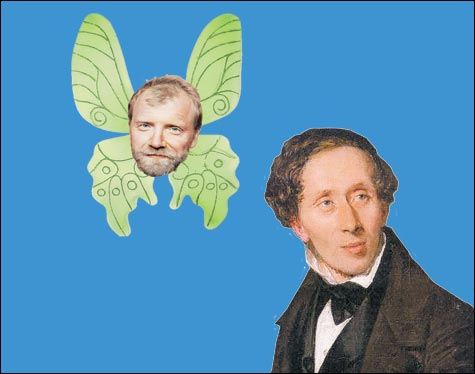
FAIRY-TALE MASTERS: George Saunders (top-left) has inherited the throne of fablemaster Hans Christian Andersen. |
Somehow, somewhere, seven-plus years into the ruinous dauphinage of G. W. Bush, with a national-security apparatus that cries “Wolf!” at its own convenience and a mass media apparently run from the boudoir of the Ugly Sisters, we seem to have forgotten the meaning of the fairy tale.
“Give me a break!” said Bill Clinton up in New Hampshire a couple of weeks ago, referring, in no very complimentary manner, to the supposedly prescient opposition of Barack Obama to the Iraq War. “This whole thing is the biggest fairy tale I’ve ever seen!” The December nuptials of Josh Kelley and Knocked Up’s Katherine Heigl, meanwhile, were hailed everywhere as “a fairy-tale wedding,” meaning: perfect and lovely!
Clearly some debasement of ideas has occurred, because here’s the thing: if the Obama campaign were dealing in fairy tales, then the Snow Queen Hillary, shedder of icy tears, would be due for a magical usurpation. And if Heigl’s had really been a fairy-tale wedding, then a funny little man who looked like a goiter on legs would have shown up at the reception and demanded with complete impunity that she pledge to him her first-born.
Our definitions have gone astray. It’s time to revisit the source. So come with me now into the weirdo woods of Fairyland, amid whose knotty grottoes we’ll see — if we’re good little children — George Saunders performing a moonlit pas de deux with the greatest storyteller of them all.
Let me give you a Hans with that
Hans Christian Andersen, were he with us, would be 203 this April. Virginal, long-nosed, and Danish, Andersen (or HCA, as I’m going to call him) was the author of “The Ugly Duckling,” “The Snow Queen,” and “The Little Mermaid.”
Yes, that’s right, the author. These spooky immemorial motifs, these comedies with the ancient and dreamlike veracity of parable, HCA made them up — and rather recently, too. (Norton, by the way, has just produced a gorgeous annotated and newly translated mega-edition of the tales, edited by Maria Tatar.) Fate gave HCA’s genius a head start: his grandfather was the village idiot, garlanding himself with beech leaves, and his father had the number-one fairy-tale job: shoemaker. (Number two is woodcutter.)
Not a folklorist like the Brothers Grimm, plodding about the Black Forest with paper and pen, nor a refiner of fables like Charles Perrault, HCA was an originator whose freaky little productions entered almost instantaneously into the symbolic life of the species. Bush strutting across the deck of the USS Lincoln, under a banner proclaiming MISSION ACCOMPLISHED: is it possible to contemplate this moment, in its tin-pot illusion, without recourse to HCA’s “The Emperor’s New Clothes”? In the city of Copenhagen, on the other hand, there is a statue of his little mermaid whose head has twice been sawn off by radical feminists, in protest against that story’s non-progressive, all-for-the-love-of-the-prince theme. Fairyland can strip a king naked, but it is by no means politically correct.
George Saunders will be 50 in December. Friendly, ginger-receding, and Texan-Chicagoan, Saunders is the author of Pastoralia, In Persuasion Nation, and The Brief and Frightening Reign of Phil, and it will be my earnest contention until the bottom of the next page that he is our own HCA — a true, health-dealing fabulist whose goofs and projections, if judiciously taken, can inoculate us against the sickness of the times.